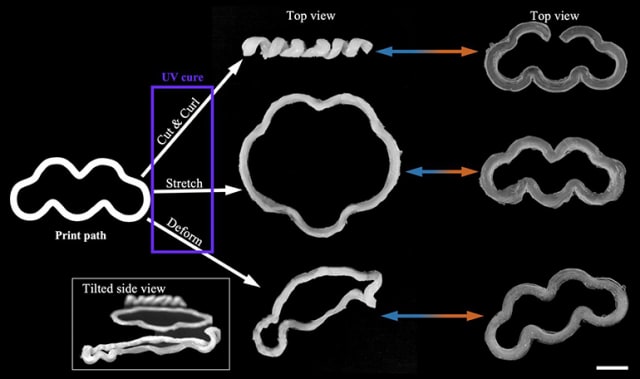Jennifer Seaton posted on August 25, 2020 |
Potential applications include adaptive biomedical implants.

Image Courtesy of Rice University.
Researchers from Rice University have developed a new 3D printing technique that creates soft shape-shifting materials. This process is being dubbed “reactive 4D printing” because it prints soft materials that can repeatable shift between two different shapes. The shape-shifting materials respond to various stimuli, including stress, heat and electric current. This will allow the structures to change their shape autonomously.
The technique requires printing a structure and embedding two sets of chemical links that control the structure’s shape. Rafael Verduzco, one of the researchers pioneering the technique, explained “We needed a method to control and define this shape change. Our simple idea was to use multiple reactions in sequence to print the material and then dictate how it would change shape.”
This process involves printing the material in an initial shape to establish one set of chemical links. The material is then mechanically distorted into a programmed shaped and cured with UV light to establish a second set of chemical links. Heat, electrical current or mechanical stress can then be used to activate one of two shapes.
Reactive 4D printing has applications in soft robotics. Currently, soft robots cannot easily change or distort their shape; they depend on gas or fluid-mediated actuation to bend or change their shape. Soft shape-shifting materials that can react to an external stimulus could increase the abilities of soft robots and unlock new functionality.
An area where the application of soft robotics is particularly relevant is robotic implants. Soft robotic implants bend and move with the body more naturally, as opposed to rigid implants that risk irritating or damaging soft tissue. The potential flexibility of the new soft shape-shifting material could better address a variety of therapeutic applications that benefit from adaptive biomedical implants.
A current limitation of reactive 4D printing is that unsupported structures cannot be printed yet. Currently, the process requires printing a liquid crystal elastomer precursor solution in a catalyst solution. Creating unsupported structures would require a gel catalyst solution that could support the structure while it is being printed.
The research team’s future work will concentrate on continuing to optimize the printing formula. Morgan Barnes, a graduate student on the team, said, “This opens the door to printing soft robotics that could swim like a jellyfish, jump like a cricket, or transport liquids like the heart.”
"soft" - Google News
August 25, 2020 at 08:06PM
https://ift.tt/3gnjUAc
New 3D Printing Technique to Create Soft Shape-Shifting Materials - ENGINEERING.com
"soft" - Google News
https://ift.tt/2QZtiPM
https://ift.tt/2KTtFc8
Bagikan Berita Ini














0 Response to "New 3D Printing Technique to Create Soft Shape-Shifting Materials - ENGINEERING.com"
Post a Comment